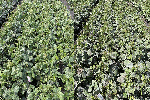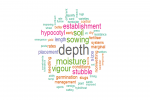Key points
- Tim Whitehead’s barley won a GRDC Hyper Yielding Crops initiative award
- The dryland crop was the highest yielding in Victoria
- It returned 74.43 per cent of its potential yield, which had been estimated at 10.48t/ha
- The Hyper Yielding Crops initiative, led by Field Applied Research Australia, spans the high-rainfall areas of Victoria, South Australia, Tasmania, southern New South Wales and Western Australia
- Its focus is helping growers in those areas to close the gap between actual and estimated cereal grain yield potential
For award-winner Tim Whitehead, the real value in the Hyper Yielding Crops initiative was peer-to-peer learning, led by the team at Southern Farming Systems
In a high-rainfall zone there can be too much of a good thing, making effective drainage the key to producing profitable crops.
But access to more suitable new varieties will also be essential if they are to close the gap between actual and potential yields, according to newly crowned award-winning mixed farmer Tim Whitehead.
A barley crop produced by Tim won the Victorian section of the fourth annual GRDC Hyper Yielding Crops (HYC) initiative.
Tim, who farms with his wife, Belinda, and father, Tim senior, at Spring Creek, near Minhamite in the state’s south-west, harvested 7.8 tonnes per hectare of RGT Planet barley in December 2023. The crop was the highest yielding in Victoria and returned 74.43 per cent of its potential yield, which had been estimated at 10.48t/ha. Nationally, the 120ha paddock ranked sixth for yield, behind crops from Tasmania and South Australia, and fifth for percentage of potential yield, behind crops from South Australia and Western Australia.
But Tim does not expect to see regular 10t/ha cereal crops any time soon. “People talk about 10-tonne potential, but we don’t see that too often,” he says. “I’ve seen it on the yield monitor, but I haven’t seen it as a consistent average.”
Indeed, Tim says yields for most crops have been poor, thanks to a run of wet seasons and lack of sunlight. While some Wimmera growers may have experienced three of their best years recently, the Whiteheads recorded a significant downturn.
“Across the board, it’s been knocked around by the wet in the past three years: lambing percentages, lambing growth rates, crop growth rates, yields in crops, yields in kilograms of meat per hectare, everything dropped by 25 per cent,” he says.
But despite a tough start to 2023, Tim says those crops did exceptionally well. “Corner to corner of every paddock is solid, which is rare for us,” he says.
Winning details
The HYC-winning barley was sown on 10 May 2023 at a seeding rate of 100kg/ha using a 12-metre Horsch Sprinter equipped with tynes on 250-millimetre row spacings.
The seed was treated with Vibrance® and Cruiser® 350FS to prevent loose smut, bunts, Rhizoctonia and Pythium, as well as insect pests such as aphids and wireworm.
A pre-emergent herbicide mix of trifluralin at two litres a hectare and glyphosate also at 2L/ha were applied for early-season control of ryegrass and other weeds, along with sulfate of ammonia at 1kg/ha and Collide 700 at 250 grams per hectare.
The crop was sown with starter fertiliser of monoammonium phosphate at 80kg/ha and flutriafol (250g/L) at 300 millilitres per hectare.
Post-seeding, the barley crop was top-dressed twice with urea, providing a total of 225kg/ha of nitrogen for the season.
It also received foliar sprays of zinc and copper in August, and the fungicides Aviator® Xpro® (bixafen and prothioconazole), Prothio T420 (prothioconazole and tebuconazole) and a blend of epoxiconazole and Amistar® 250 (azoxystrobin) at growth stages 31, 33 and 59.
In-crop herbicide applications included Mateno® Complete (aclonifen and diflufenican and pyroxasulfone) at GS13 in May, followed by MCPA LVE 570 at GS31 in August.
Insect pressure was low during the season and no pesticide sprays were needed.
The plant growth regulator Moddus® Evo (trinexapac-ethyl) was applied at 200mL/ha in September at GS33 to reduce the risk of lodging and improve efficiency at harvest on 20 December.
As well as continuously cropping 1350ha of undulating country with soil types ranging from silty and sandy loam to volcanic, the Whiteheads run a flock of self-replacing composite ewes, producing about 10,000 lambs each year. The sheep graze on permanent pastures of ryegrass and clove in winter and 100ha of brassica forage crops over summer.
“This is mainly a livestock area,” Tim says. “There’s not a lot of crop south of us, really, until you hit Tasmania.”
Raised beds
After converting to raised beds about 20 years ago, the Whiteheads lifted their cereal yields to 6 to 7t/ha compared with the Western Districts’ average of 4.5t/ha. They found compaction was causing problems after using a disc seeder and reverted to ripping the beds.
Acquiring a 12m KB grader board has allowed them to do a better job of levelling the ground before reforming the beds, adding another 0.5t/ha to yields in some paddocks.
Tim concedes there is significant capital tied up in machinery and a lot of work involved, with renovation required every one to three years, but they have crunched the numbers and it pays off. “If we maintain the beds, we grow better crops,” he says.
As well as producing barley for grain, the Whiteheads grow wheat, canola and faba beans. Crops in 2024 include four canola varieties – 45Y28 RR, Hyola® 525 RT, InVigor® 4520 P and 45Y95 CL – PBA Amberley faba beans, BigRed feed wheat and RGT Planet barley.
The rotation usually incorporates a double break for managing disease and problem weeds, such as annual ryegrass, brome grass and wild radish, with faba beans followed by canola and wheat or barley.
Tim says they stopped growing barley for a period when prices were low and in-crop ryegrass suppression difficult.
“We used to like growing it; we found we could grow pretty good yields,” he says. “It would get wet sometimes, but with the drainage, we’ve got on top of that so we’ve gone back into growing barley. We can spray-top it if we have a blowout. Now we’ve got Mateno® (which became commercially available in 2022) that’s made it a lot easier.”
Tim says he would like to see more effort put into developing or importing suitable new wheat and legume varieties with improved disease resistance.
“I think we’re hitting a wall; the wheat seems to break down in disease resistance very quickly,” he says. “There are European varieties that would suit us down here but take too long to come through.
“We also need more break crops. Lentils and chickpeas are too short for us to grow here. We have volcanic country and stones, and we’re pretty undulating too, so it would be hard to harvest.”
Competition tests
Extensive soil and grain tests carried out as part of the HYC, which the Whiteheads would not normally do, were useful for showing up potential deficiencies in both major and trace elements.
One of the most valuable aspects of the experience was the discussion groups, Tim says.
That was probably the best part of it, having Jon Midwood and the Southern Farming Systems team getting us together and passing on all their knowledge to the group, and stimulating conversation within the group, where we could all talk about different issues and problems that we’d had and brainstorm.
As a result, Tim says they have renewed their focus on rotation and matching nutrition to each crop’s needs. He also notes that it can be too easy to fall into a strategy of saving money: “If you’ve had a wet year, you think ... we’d better be careful.” But he says his experience has shown the benefit of using and maximising that moisture. “We just need to feed the crops, and when we do that, we’re seeing good results.”
This includes spending more on nitrogen, potash and phosphorus fertilisers as well as copper, and applying a flat rate of 2.5t/ha of lime in front of canola or faba beans as part of their long-term program to address soil acidity.
GroundCoverTM story: Advancing cereal yield frontiers

























































